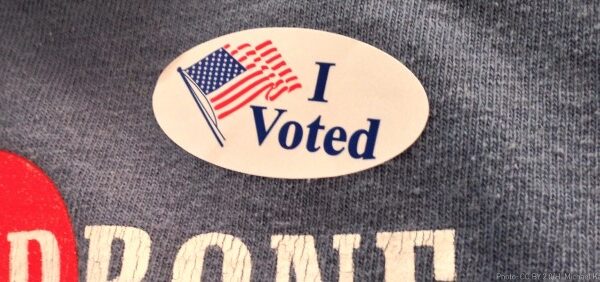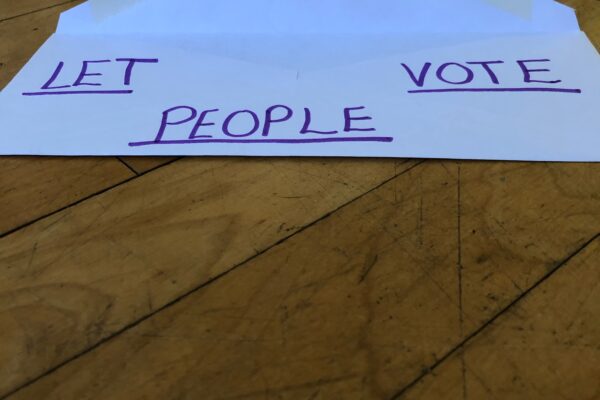By creating more equal access to the ballot box, early voting gives more people a chance to make their voices heard. Early voting is a particularly crucial option for voters who are vulnerable to disenfranchisement because of physical disabilities, lack of transportation, lack of childcare, long lines at their polling places, or unpredictable work schedules.
Most states have recognized that early voting is an important part of strengthening our democracy: Connecticut is one of only 11 states nationwide that does not allow some form of early voting.
This year, a bill in Connecticut’s legislature could have set our state on the path toward changing this. The bill would remove the state constitution’s current prohibition on early voting and give the General Assembly the authority to allow in-person early voting.
Because of a vote in the state Senate, Connecticut voters won’t get to weigh in on early voting in 2020 – but we could get to decide in 2022. Here’s a quick breakdown of what just happened with early voting, and what’s next:
1) Early voting in our state would require an amendment to the state Constitution, which currently requires voting in person on Election Day, with the exception of absentee voting.
2) One way to amend the state Constitution to allow early voting would be for Connecticut voters to first approve a ballot question to give the legislature the power to do so.
3) There are two ways the legislature can pose that question to Connecticut voters. One way is for the legislature to adopt a resolution (same process as passing a bill) by a super majority of 75% in each chamber during one legislative session. If this happens, the question would go on the next regular state election ballot. The other way is for the legislature to adopt a resolution by a simple majority of more than 50% in both the House and Senate in two successive legislative terms, which are two years each. This means that if the legislature adopts a resolution by a simple majority in the first year of a new legislative term, the resolution must be adopted by a simple majority by the legislature serving two years after that session.
4) In 2019, the legislature introduced House Joint Resolution 161, A Resolution Proposing An Amendment to the State Constitution to Allow for Early Voting. This resolution would give Connecticut voters the chance to decide whether to give the legislature the go-ahead to adopt a resolution to allow early voting in our state. Under the resolution, the following question would appear on Connecticut voters’ ballots: “Shall the Constitution of the State be amended to permit the General Assembly to provide for early voting?"
5) In order for the question to appear on Connecticut voters’ ballots in 2020, the 2019 legislature would need to adopt the resolution by a super majority of 75% in the House and in the Senate.
6) On April 24, 2019, the resolution was adopted by the House of Representatives with the necessary 75% of the vote — 125 to 24.
7) On May 8, 2019, the resolution was adopted by the Senate with a majority of votes, but not the 75% necessary to put the early voting question on the ballot in 2020. The final vote count was 23 to 13—just four votes shy of the 27 needed— with Senators Fasano, Witkos, Bizzarro, Kissel, Sampson, Logan, Somers, Formica, Kelly, Miner, Martin, Berthel, and Champagne voting against giving Connecticut voters the chance to decide on early voting.
8) The 2019 legislature failed to adopt the resolution in a way that would allow it to be on the ballot for 2020, but the resolution is still alive for the next legislature to tackle. The next legislature would again need to adopt the resolution with a simple majority for the early voting question to appear on Connecticut voters’ next regular state election ballots. Because Connecticut’s legislature functions in two-year terms, the earliest the resolution could be adopted for the second time is 2021, when the technically “new” legislature begins its term.
9) In 2021, the House and Senate can each bring the early voting resolution up for a vote again. If the House and the Senate adopt the resolution with a simple majority, the earliest the question could appear on Connecticut voters’ ballots would be 2022.
10) If the majority of Connecticut voters approved the amendment to the Constitution by voting “Yes” in response to the ballot question, the legislature would be empowered, by the voters, to pass a law to allow early voting. The earliest the legislature could vote on a bill allowing Connecticut voters to vote early would be 2023, and the bill would need to pass the legislature by a simple majority.
11) If the legislature passed the bill in 2023, Connecticut voters could be able to vote early in 2024.
So, the early voting resolution is dead; long live the early voting resolution. While the resolution failed to be adopted by enough legislators in 2019 to get on the next ballot, it did pass both chambers with a majority, and with bipartisan support in both places. And the resolution will be up again, which means all of us, as Connecticut residents and voters, need to be ready to tell our legislators to vote for early voting again in 2020.
The ACLU of Connecticut has been fighting for early voting for years, and we aren’t about to stop now. We’ll keep up the fight to make sure Connecticut voters, like our fellow Americans in 39 other states, can vote early.





